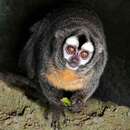fr
noms dans le fil d’Ariane


Night monkeys have very large eyes and use their sense of vision extensively. They have excellent vision in low light and can see in color. They communicate with vocalizations and with chemical cues. A captive night monkey was reported to use as many as 50 different kinds of vocalizations. Calls in the night are described as squeaks, hisses, and barks and the throat sac can be inflated to add resonance to calls. The alarm call is described as a "wook." They use glands on the throat and at the base of the tail to mark their surroundings and practice "urine washing," in which they coat their hands and feet with urine. The scent is then transferred to objects as they move about.
Communication Channels: visual ; tactile ; acoustic ; chemical
Other Communication Modes: pheromones ; scent marks
Perception Channels: visual ; tactile ; acoustic ; chemical
Aotus species are includes in CITES Appendix II and are considered "least concern" for extinction by the IUCN, with the exception of A. lemurinus and A. miconax, which are considered vulnerable.
There are eight species of night monkeys, also commonly called douroucoulis or owl monkeys, found from Panama to Peru, Bolivia, and northeastern Argentina. Douroucoulis are the only nocturnal monkeys in the New World. They are small monkeys found exclusively in forests. They are characterized by large eyes, flat, rounded faces, and dense, woolly pelage.
There are no known adverse effects of night monkeys on humans.
Night monkeys are important members of native forest ecosystems in South America. They may contribute to ecotourism, although their nocturnal and arboreal habits make them difficult to see. They may also help to disperse seeds through their frugivory. Night monkeys are used as a research model in the study of malaria because they are naturally resistant to the protozoan parasites that spread the disease (Plasmodium falciparum).
Positive Impacts: ecotourism ; research and education
Night monkeys may help to disperse the seeds of the trees they forage in.
Ecosystem Impact: disperses seeds
Night monkeys eat fruit, nuts, leaves, bark, flowers, plant gums, insects, and small vertebrates. Night monkey species that occur in tropical lowland forests eat a larger proportion of fruit, as fruit is more consistently available throughout the year. In dry forests, where fruit is seasonally available, night monkeys eat more leaves. They prefer small, ripe fruits and tend to forage in large canopy trees. They capture invertebrates, including moths, large orthopterans, beetles, and spiders, by grabbing them out of the air or chasing them down on tree branches.
Primary Diet: omnivore
Night monkeys are found in southern Central America through South America as far south as Bolivia, northeastern Argentina, and Paraguay. The genus Aotus is the second most widely distributed New World monkey genus, with howler monkeys (Alouatta) being more widely distributed.
Biogeographic Regions: neotropical (Native )
Night monkeys occur in a wide variety of forested habitats, from tropical lowland forests to cloud forests and in gallery forests, deciduous and semi-deciduous forests, dry forests, and mangrove swamps. They are found in primary, secondary, and remnant forests.
Habitat Regions: tropical ; terrestrial
Terrestrial Biomes: forest ; rainforest ; scrub forest
Other Habitat Features: riparian
In the wild the oldest known night monkey individual was 13 years old. In captivity they have been known to live to 20 years old.
Night monkeys are small monkeys, from 455 to 1254 grams in weight and from 240 to 370 mm in head and body length. The tail is not prehensile and is from 316 to 400 mm. Males and females are similar in size and appearance. Pelage color and pattern is somewhat similar across species, with short, dense, woolly fur that is silvery gray dorsally and yellow or buff to orange-brown ventrally. The face is round and usually marked with 3 dark brown or black lines; one line on either side of the eyes and one marking the middle of the forehead. They have white or light gray areas of fur above and below their exceptionally large eyes and on the chin. In some species these markings are indistinct. Gray-necked species have grayish fur on the sides of their necks, red-necked species have red fur on the sides of their necks. The ears are short and rounded, sometimes completely covered by the thick fur. Night monkeys have a sac under their chin that can be inflated during vocalizations.
Other Physical Features: endothermic ; homoiothermic; bilateral symmetry
Sexual Dimorphism: sexes alike
Little is known about predation on night monkeys. Potential predators include owls, arboreal snakes, and felids. Diurnal birds of prey may take night monkeys that are not well hidden in daytime sleeping spots. Their nocturnality and their presence in the high canopy of forests protects them from many predators. Their coloration also makes them difficult to spot in low light in the high forest canopy.
Anti-predator Adaptations: cryptic
Field studies have all reported that night monkey pairs are monogamous, with family groups being formed around these monogamous pairs.
Mating System: monogamous
Most information on mating in night monkeys is from captive populations, although some information from wild species is available. Gestation lengths have been reported from 122 to 153 days and a single young is born. Birth weight is about 80 grams. Sexual maturity is reached at about 2 years old.
Key Reproductive Features: iteroparous ; seasonal breeding ; gonochoric/gonochoristic/dioecious (sexes separate); sexual ; viviparous
Observations on wild and captive populations indicate that both males and females care for their young. Night monkeys occur in small family groups made up of a mated pair and their offspring.
Parental Investment: altricial ; pre-fertilization (Provisioning, Protecting: Female); pre-hatching/birth (Provisioning: Female, Protecting: Female); pre-weaning/fledging (Provisioning: Female)